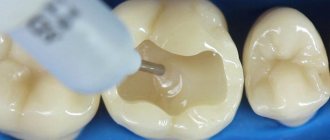What is a photopolymer filling?
Photopolymer filling is a popular and convenient way to restore teeth, which uses photopolymer materials.
Composites harden in the oral cavity solely under the influence of a specific wave of light emanating from a lamp. Thanks to this property, the dentist can do his work slowly and creatively.
In addition, light-reflecting composites are available in different colors and degrees of transparency, and accordingly, with their help it is possible to hide darkened hard tissues and even metal, as well as restore enamel and dentin.
There is also technology that allows you to combine reflective and chemical materials. It is in this case that it is possible to make the most of all the advantages and neutralize the disadvantages of each method.
There are many reasons why photopolymer fillings are widely used in dentistry. The risk of cracks occurring during operation is minimized. All functions of the teeth are completely restored, while the patient’s sensations remain the same as with healthy teeth.
Material composition
Light-curing materials for filling must meet certain criteria, among which the primary role is given to biocompatibility and safety for the patient’s health. The composition of a composite usually includes several components: a polymer matrix, a filler, for example, silica particles, and a binder1. It should be noted that the composition of the material used is selected based on the location of the tooth that needs treatment. Under the influence of an ultraviolet lamp, polymerization processes are activated - the composition hardens.
Kinds
Regardless of the type, a composite material is used to make a photopolymer filling. He can be:
- macro-filled;
- microfilled;
- minifilled;
- hybrid;
- compomer.
In addition, composites are divided into fluid and solid. They are placed in syringes and applied to the surface to be treated using tools specially designed for this purpose. Conventional ones are not suitable for this purpose, as the material will stick to them.
In case of restoration of the interdental contact point, as well as when filling the cervical area, they resort to the use of fluid polymer fillings.
It is they that fit as tightly as possible and are evenly distributed over the surface, due to which they create tight contact with hard tissues. They are easy to use. In this case, the possibility of applying more composite than necessary is completely excluded.
Let's find out why a tooth hurts after a temporary filling
In the process of restoration of anterior teeth, it is customary to use solid photopolymers. They are plastic, thanks to which they can give the tooth any shape and will fully correspond to the anatomical structure.
When restoring a large cavity, the material is applied in layers, since the rays of the lamp cannot penetrate into the deep layers. For more reliable fixation, the enamel is highlighted first and only then the remaining areas.
Indications and contraindications
There are a number of indications for which the use of photopolymer materials is used. The main ones:
- tooth fracture;
- change in color of enamel that cannot be bleached:
- significant defects of tooth enamel;
- the presence of large fillings in the cervical area;
- noticeable interdental gaps;
- the need for minor correction of the position of the teeth;
- damage to the crown by a maximum of forty percent.
Even if there are indications for installing a filling, a specialist may refuse to carry out the necessary treatment. Among the main contraindications for installation are the following:
- bruxism;
- severe destruction of the front teeth;
- active development of caries;
- teeth subjected to intensive fluoride treatment;
- lack of proper oral hygiene.
Some of the contraindications are classified as conditional. Over time, they can be eliminated, and, accordingly, there will no longer be barriers to installing fillings made of photopolymer materials.
In what cases is it used?
Indications:
- carious and non-carious destruction;
- pathological changes in the size and color of crowns;
- injuries requiring restoration of chips, correction of damaged teeth (only if the coronal part is preserved at least 50%);
- pathological mobility I-III degrees (have a holding effect);
- small enamel defects (light-curing compounds allow you to create patches in small areas where other compounds will not adhere).
Installation
The process of installing a photopolymer filling is carried out in several stages. Most often, treatment is carried out according to this plan:
- Administration anesthetic drug.
- Preparation of the area affected by caries.
- Treatment with medications.
- Isolation of saliva and mandatory drying.
- Application of acid to improve adhesion.
- Thorough rinsing and drying.
- Application of adhesive material.
- Layer-by-layer application of the composite.
- Polishing and grinding.
If the depth of the lesion is too great, then additionally resort to the use of a therapeutic and insulating pad. If dentin layers are damaged, they must be isolated. In those cases when the cavity is excessively large, first a medicinal material is placed into it and only then an insulating material.
The process of etching the enamel can be carried out both before and after insulation. The gel, which contains orthophosphoric acid, is applied exclusively to the dried surface. Only in this case will it be possible to achieve the desired effect.
After applying the adhesive system, it is sprayed using an air stream. Then the material is illuminated with a lamp for literally half a minute. The filling is formed by layer-by-layer application of reflective material.
At the final stage of installation, the filling is ground, removing all irregularities and polished. The tooth acquires natural smoothness and shine. It is almost impossible to distinguish it from natural one.
What does the cost depend on?
Everyone probably knows that treatment and installation of a filling is quite expensive. This depends on many factors that the doctor takes into account when determining the total cost. Typically, when treating and installing a filling product, the following important components are used:
- Expensive medicinal materials;
- High-quality filling compounds;
- Use of expensive equipment;
- Highly professional dentist.
Therefore, you should not be surprised that comfortable treatment, infection and filling of teeth will cost a tidy sum. However, the cost may differ each time. Sometimes you can cure a tooth in just one visit, and sometimes several visits may be required, and the cost will vary significantly. In addition, the cost depends on the stages of treatment. Typically, all dental clinics have a standard list of treatment stages, which includes the following services:
- Initial examination;
- Cleansing the affected area;
- Administration of the drug;
- If the need suddenly arises, an X-ray examination is required, in which a photograph of the tooth roots is taken;
- Carrying out cleaning and formation of channels;
- Removal of nerves;
- Canal filling;
- Installation of a temporary filling;
- Installation of a permanent filling.
The cost of all these services can be found in clinic price lists. In addition, the cost may vary depending on the type of filling. Fillings made from a composite or luminous material will be much more expensive than simple cement or plastic products.
Care
The rules for caring for photopolymer fillings are practically no different from ordinary oral hygiene.
Patients simply need to brush their teeth regularly with a soft toothbrush and rinse their mouth with warm water or a special solution after each meal.
It is also important to regularly, at least once every six months, have a routine examination with a dentist. Only if problems are detected in a timely manner can they be easily eliminated and the development of more serious diseases prevented, and accordingly preserve the integrity of the tooth that has been restored.
Life time
The service life of photopolymer fillings largely depends on the quality of the material and the competence of the specialist. In addition, the patient himself is able to both shorten and significantly extend the service life of the filling.
The materials used in the filling process can be either highly durable or less reliable. Provided that a high-quality composite is used, it can last up to seven years.
There are cases when the filling falls out almost immediately after its installation. There may be several reasons for this. It is possible that when filling, the doctor made a mistake, as a result of which the material was not securely fixed. The most common cause is adhesion failure due to saliva or liquid.
Find out why a tooth hurts after filling
In such cases a guarantee is issued. Within a year after the filling is installed, the patient can apply for a repeat procedure. There is no charge for the service.
It is also possible that the patient simply did not follow all medical recommendations. In this case, you also need to seek help from a specialist. It is advisable to give preference to those clinics that have only positive recommendations. In this case, the risk of the filling falling out will be minimal.
Let's sum it up
There are many types of dental fillings for filling teeth, which differ in materials of manufacture, purpose and other criteria. The type of product is selected together with the attending physician. In this case, it is important to take into account the quality of adhesion to natural surfaces, aesthetic properties, hardening speed and other points. For many patients, the cost of installation is a deciding factor, so strength and durability take a back seat.
The price depends on many factors, for this reason it is important to carefully consider the choice of treatment method. Having figured out what types of permanent dental fillings there are (the names of the types are discussed above), you can forget about pain and other discomfort for a long time, enjoying a dazzling smile.
Do's and don'ts after installation
When installing light fillings, the doctor gives a number of recommendations, following which it is possible to preserve their integrity for many years. The most important of them are the following:
- Eliminate viscous foods from the diet that can lead to loss of the composite.
- Avoid excessively hard foods such as nuts and crackers, especially in cases where the front teeth have been restored.
- Get rid of the habit of biting your nails and biting threads.
- Brush regularly, at least twice a day .
- professionally once every six months . In this case, be sure to inform the specialist that photopolymer fillings have been installed and indicate their exact location.
- For several days after the filling is installed, do not eat foods that contain dyes. Otherwise, the material will darken and the tooth will lose its natural appearance.
The main advantage of fillings made from photopolymer materials is that you can eat food immediately after the procedure. If chemicals are used, it is necessary to wait at least two hours for the cement to completely harden.
How much does a filling cost?
In Moscow, prices for the simplest products start at 400 rubles. Composite fillings can cost up to 2 thousand rubles apiece. Ceramic inlays are the most expensive, since they are more related to microprosthetics. The price of the product depends not even on the material, but on the complexity of the shape of the filling and the time spent on manufacturing. The more complex the work, the higher the cost.
In public clinics, fillings are performed free of charge. Only the most affordable cement materials are used. If you want a higher quality product, you will have to pay extra.
Everyone will have to deal with a filling at least once, so this information will be useful to everyone. If you don’t know what dental fillings are, you simply won’t be able to choose the best option for yourself.
Advantages and disadvantages
The demand for photopolymer fillings is due to a number of their advantages. The main ones are the following:
- it is possible to accurately restore the relief and shape of teeth even in cases where they are too damaged;
- the filling is combined with hard tissue into a single whole thanks to a special adhesive system;
- after hardening, the material becomes durable, securely bonded to the enamel, and resistant to cracking;
- it is possible to achieve the desired cosmetic effect by selecting the desired color shade of the material;
- installation is carried out by applying the composite layer by layer, thereby creating an imitation of natural dental tissues;
- preparation of cavities and defects is reduced to a minimum;
- In case of delamination or chipping, adhesive correction is possible.
Among the disadvantages of such fillings, one can highlight only shrinkage of the composite when exposed to light and insufficient polymerization. The polymer does not harden completely, and therefore the original shade may change over time.
Photopolymer fillings have many advantages, which is why they are most often used in dentistry. This is a reliable type of dental restoration, with the help of which it is possible to give even severely damaged hard tissues a natural appearance.
Another peculiarity of the use of light composites is that the material hardens only under the influence of a special lamp. Accordingly, the specialist has the opportunity to clearly recreate the natural shape of the tooth, which is very difficult when using other materials.











